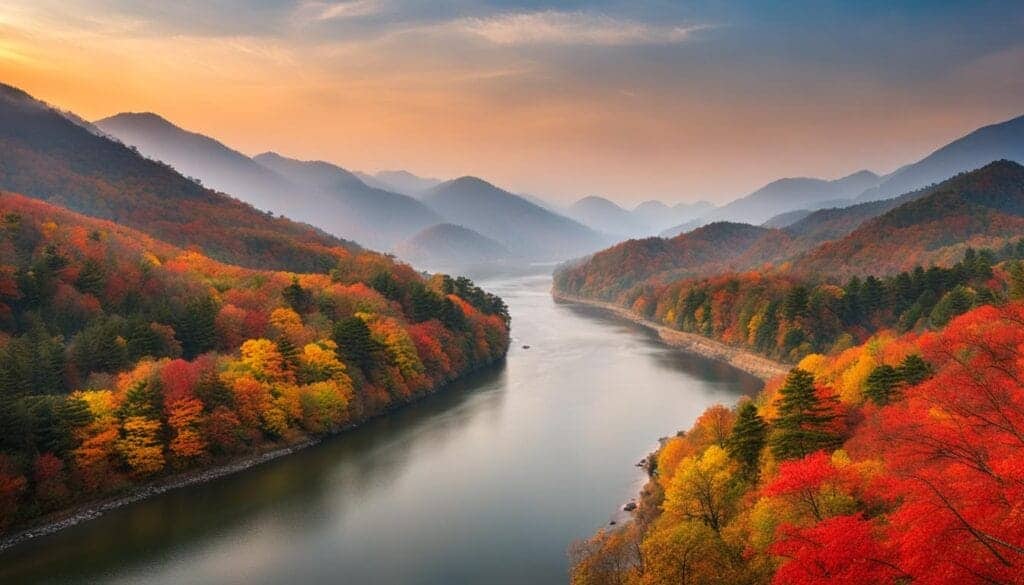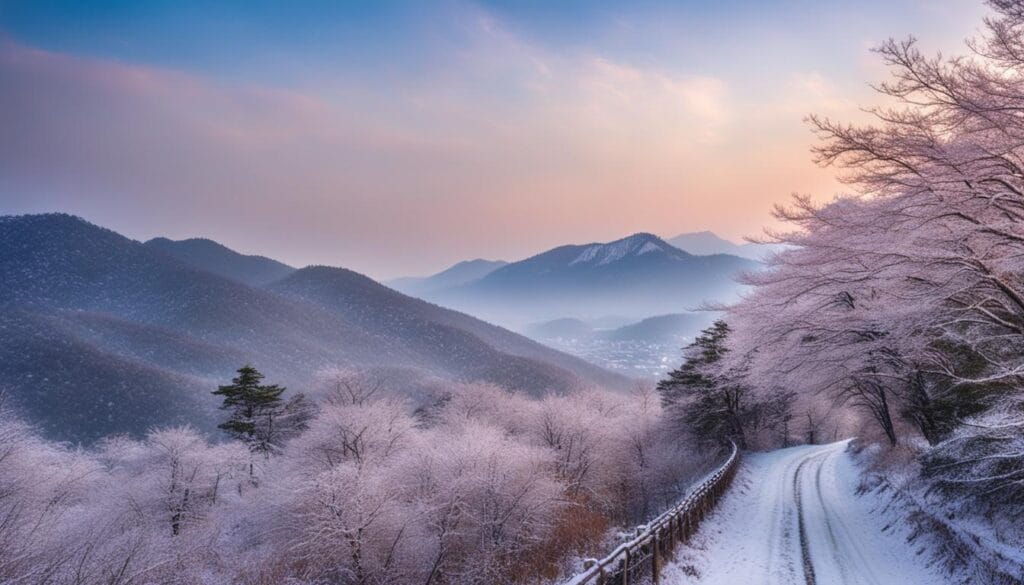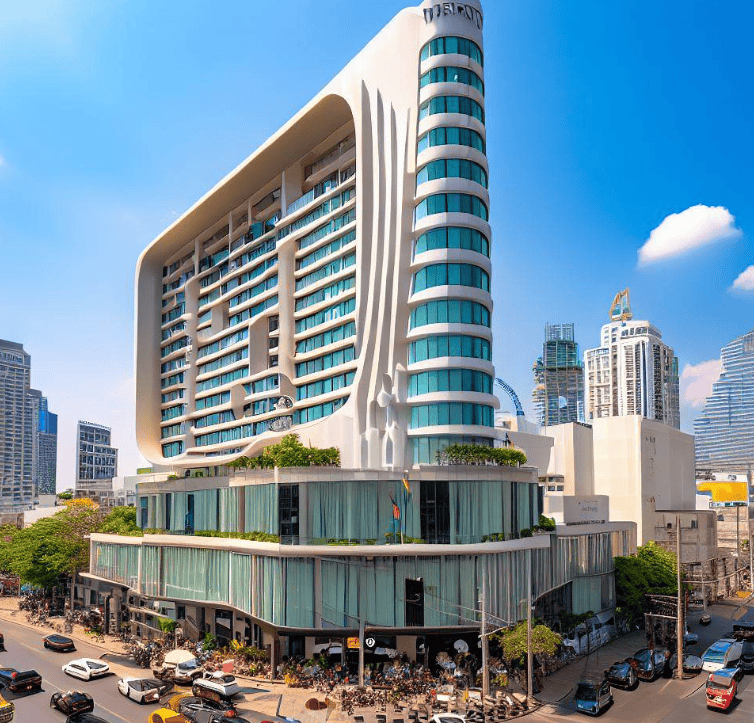South Korea, a country that seamlessly blends ancient traditions with cutting-edge technology, has become a dream destination for many travelers. From the bustling streets of Seoul to the serene landscapes of Jeju Island, there’s no shortage of captivating experiences waiting to be discovered.
However, planning the perfect trip to South Korea involves more than just choosing your destinations and activities. One crucial factor that can greatly impact your overall experience is the timing of your visit.
Different seasons bring unique charms, festivals, and weather conditions that can either enhance or hinder your travel plans. So, when is the best time to embark on your South Korean adventure? Should you opt for the mild temperatures and cherry blossoms of spring, the lively festivals and beach getaways of summer, the stunning foliage and harvest celebrations of autumn, or the snowy landscapes and winter sports of the colder months?
In this comprehensive guide, we’ll explore the pros and cons of visiting South Korea during each season, helping you make an informed decision based on your preferences and priorities.
Factors to Consider When Deciding the Best Time to Visit South Korea
Weather and Climate
South Korea experiences four distinct seasons, each with its own unique weather patterns and temperatures. Spring (March to May) and autumn (September to November) are generally considered the most pleasant times to visit, with mild temperatures and minimal rainfall.
These seasons are perfect for outdoor activities, sightseeing, and exploring the country’s stunning natural landscapes.
Summer (June to August) in South Korea can be hot and humid, with temperatures often reaching over 30°C (86°F). This season also brings the monsoon rains, which can be heavy at times but usually only last for a few weeks.
Despite the heat and occasional downpours, summer is a popular time for beach getaways and outdoor water activities.
Winter (December to February) in South Korea can be cold, with temperatures dropping below freezing in some parts of the country. However, if you’re a fan of winter sports or enjoy the beauty of snowy landscapes, this season can be a magical time to visit.
The famous ski resorts in Gangwon Province, such as Yongpyong and Alpensia, attract winter sports enthusiasts from around the world.
| Season | Average Temperature (°C) | Average Rainfall (mm) | Pros | Cons |
|---|---|---|---|---|
| Spring | 5-20 | 50-100 | Mild weather, cherry blossoms | Occasional yellow dust from China |
| Summer | 20-30 | 100-300 | Beaches, outdoor activities | Hot and humid, monsoon rains |
| Autumn | 10-25 | 50-100 | Comfortable weather, stunning foliage | Occasional typhoons |
| Winter | -10-5 | 20-50 | Winter sports, snowy landscapes | Cold temperatures, dry air |
Festivals and Events
South Korea is a country that loves to celebrate, and there are numerous festivals and events throughout the year that showcase the nation’s rich culture and traditions. Timing your visit to coincide with one of these celebrations can add an extra layer of excitement and memorable experiences to your trip.
In spring, the Cherry Blossom Festival is a must-see event, with thousands of beautiful pink and white flowers blooming across the country. The Jinhae Gunhangje Festival in Jinhae-gu, Changwon, is one of the most famous cherry blossom festivals, attracting millions of visitors each year.
Other notable spring festivals include the Lotus Lantern Festival in Seoul, which celebrates Buddha’s birthday, and the Damyang Bamboo Festival in Damyang-gun, Jeollanam-do.
Summer in South Korea is filled with lively festivals and events, ranging from music festivals to traditional cultural celebrations. The Boryeong Mud Festival, held in Boryeong-si, Chungcheongnam-do, is a unique and fun-filled event where participants enjoy mud wrestling, mud slides, and other mud-related activities. The Busan Sea Festival, held in Busan, the country’s second-largest city, features a variety of water sports, cultural performances, and fireworks displays.

Autumn is a time for harvest festivals and food-related events, celebrating the bounty of the season. The Andong Mask Dance Festival in Andong-si, Gyeongsangbuk-do, showcases traditional Korean mask dances and performances, while the Gimje Horizon Festival in Gimje-si, Jeollabuk-do, offers a chance to experience the beauty of the local rice fields and participate in hands-on agricultural activities.
For those passionate about Korean history and culture, the Jeonju Hanok Village Festival in Jeonju-si, Jeollabuk-do, is a must-visit event, featuring traditional music performances, handicraft workshops, and delicious local cuisine.
| Festival | Location | Date | Highlights |
|---|---|---|---|
| Jinhae Gunhangje Festival | Jinhae-gu, Changwon | Late March to early April | Cherry blossoms, military band performances |
| Boryeong Mud Festival | Boryeong-si, Chungcheongnam-do | Mid-July | Mud wrestling, mud slides, fireworks |
| Andong Mask Dance Festival | Andong-si, Gyeongsangbuk-do | Late September to early October | Traditional mask dances, cultural performances |
| Jeonju Hanok Village Festival | Jeonju-si, Jeollabuk-do | Mid-October | Traditional music, handicraft workshops, local cuisine |
Crowds and Tourist Seasons
When planning your trip to South Korea, it’s essential to consider the impact of tourist seasons and crowds on your overall experience. Peak tourist seasons, such as cherry blossom season in spring and the summer holiday period, can lead to higher prices, larger crowds, and limited availability of accommodations and transportation.
If you prefer a more relaxed and less crowded experience, consider visiting during the shoulder seasons of late spring (May) or early autumn (September). These periods offer mild weather, lower prices, and fewer tourists, allowing you to explore the country’s attractions at a more leisurely pace.
For those who don’t mind the cold, winter can be an excellent time to visit South Korea, especially if you’re interested in winter sports or enjoying the festive atmosphere of the holiday season.
Ski resorts and winter festival locations may be more crowded during this time, but cities like Seoul and Busan tend to be less busy, making it easier to explore their many attractions.
| Season | Crowds | Prices | Tips |
|---|---|---|---|
| Spring (March to May) | High during cherry blossom season | Higher during peak season | Book accommodations and transportation in advance |
| Summer (June to August) | High during summer holiday period | Higher during peak season | Avoid the monsoon season if possible |
| Autumn (September to November) | Moderate to high during fall foliage season | Moderate | Visit popular autumn destinations on weekdays |
| Winter (December to February) | Low to moderate, higher at ski resorts | Lower, except for ski resorts | Enjoy winter sports and holiday celebrations |
When deciding the best time to visit South Korea, it’s crucial to consider factors like weather, festivals, crowds, and your personal preferences.
By carefully planning your trip and taking into account the unique characteristics of each season, you can ensure a memorable and enjoyable experience in this fascinating country.
Budget and Cost Considerations
The cost of traveling to South Korea can vary depending on the season, with peak tourist periods generally seeing higher prices for accommodations, transportation, and activities. However, with some careful planning and flexibility, it’s possible to visit South Korea on a budget during any time of the year.
One way to save money on your trip is to consider visiting during the shoulder or off-peak seasons, such as late spring or early winter. During these times, prices for flights and accommodations tend to be lower, and you may be able to find discounts on tours and activities as well.
Keep in mind that some attractions or services may have reduced hours or be closed entirely during the off-peak season, so it’s essential to research ahead of time.
Another cost-saving strategy is to take advantage of South Korea’s excellent public transportation system, which includes buses, subways, and trains. Purchasing a T-Money card, a rechargeable transportation card, can help you save money on fares and make navigating the system more convenient. Additionally, consider staying in budget-friendly accommodations like hostels, guesthouses, or traditional hanok stays, which offer unique cultural experiences at a lower cost than hotels.
| Expense | Peak Season Cost | Off-Peak Season Cost | Money-Saving Tips |
|---|---|---|---|
| Flights | $800 – $1,500 | $600 – $1,000 | Book in advance, consider budget airlines |
| Accommodations | $80 – $200 per night | $50 – $150 per night | Stay in hostels, guesthouses, or hanok stays |
| Food | $10 – $30 per meal | $8 – $25 per meal | Eat at local markets, street vendors, or convenience stores |
| Transportation | $1 – $3 per subway/bus ride | $1 – $3 per subway/bus ride | Use a T-Money card, take advantage of discount passes |
For those passionate about Korean culture and history, there are many ways to experience the country’s rich heritage without breaking the bank. Visit free attractions like the Changgyeonggung Palace or the Bukchon Hanok Village in Seoul, or explore the vibrant art scene in neighborhoods like Hongdae and Itaewon.
Many museums, such as the National Museum of Korea and the War Memorial of Korea, offer free admission or discounted rates for students and seniors.
Food lovers on a budget can still enjoy the delicious flavors of Korean cuisine by eating at local markets, street vendors, or convenience stores. Dishes like kimbap (Korean-style sushi rolls), tteokbokki (spicy rice cakes), and odeng (fish cakes) are tasty, filling, and affordable options that can be found throughout the country.
By being mindful of your expenses and taking advantage of budget-friendly options, you can experience the best of South Korea without overspending. Whether you’re interested in history, culture, food, or nature, there are plenty of ways to make the most of your trip while sticking to your budget.
Best Seasons to Visit South Korea
Spring (March to May)
Spring is a magical time to visit South Korea, as the country comes alive with the beauty of cherry blossoms. From late March to early April, the delicate pink and white flowers bloom across the nation, creating a breathtaking spectacle that attracts visitors from around the world. The mild temperatures and minimal rainfall during this season make it perfect for outdoor activities and sightseeing.
One of the best places to experience the cherry blossoms is at the Yeouido Spring Flower Festival in Seoul, where over 1,000 cherry trees line the streets, creating a romantic and picturesque atmosphere. Another popular destination is the Jinhae Gunhangje Festival in Jinhae-gu, Changwon, which boasts over 350,000 cherry trees and attracts millions of visitors each year.
In addition to the cherry blossoms, spring in South Korea offers a variety of other attractions and activities. Hikers and nature enthusiasts will enjoy exploring the country’s stunning national parks, such as Seoraksan National Park in Gangwon Province, which features breathtaking mountain scenery and waterfalls.
Foodies can indulge in seasonal specialties like fresh seafood and wild vegetables, while culture lovers can attend traditional festivals like the Lotus Lantern Festival in Seoul.
| Best Spring Destinations | Key Attractions | Best Time to Visit |
|---|---|---|
| Yeouido (Seoul) | Cherry blossom festival, Han River Park | Early April |
| Jinhae-gu (Changwon) | Jinhae Gunhangje Festival, NFRDI Environment Eco-Park | Late March to early April |
| Seoraksan National Park (Gangwon) | Hiking trails, waterfalls, cable car rides | April to May |
Summer (June to August)
Summer in South Korea is a time for fun in the sun, with warm temperatures and plenty of outdoor activities to enjoy. Despite the occasional monsoon rains and high humidity, this season is perfect for beach getaways, water sports, and lively summer festivals.
One of the most popular summer destinations in South Korea is Busan, the country’s second-largest city. Haeundae Beach, located in the heart of Busan, attracts millions of visitors each year with its soft sand, clear waters, and vibrant atmosphere.
Visitors can enjoy swimming, sunbathing, and a variety of water sports, as well as explore the nearby Dongbaek Island and its scenic walking trails.
For those seeking a more unique summer experience, the Boryeong Mud Festival in Boryeong-si, Chungcheongnam-do, is a must-visit event. Held annually in July, this festival celebrates the beneficial properties of the local mud with a range of fun and messy activities, including mud wrestling, mud slides, and mud baths.
Other notable summer festivals include the Busan Sea Festival, which features water sports competitions, cultural performances, and fireworks displays, and the Pohang International Fireworks Festival, which illuminates the night sky with dazzling pyrotechnics.
| Best Summer Destinations | Key Attractions | Best Time to Visit |
|---|---|---|
| Haeundae Beach (Busan) | Swimming, sunbathing, water sports, Dongbaek Island | July to August |
| Boryeong-si (Chungcheongnam-do) | Boryeong Mud Festival, mud-related activities | Mid-July |
| Pohang-si (Gyeongsangbuk-do) | Pohang International Fireworks Festival, Pohang Beach | Late July to early August |
Autumn (September to November)
Autumn is a stunning time to visit South Korea, as the country transforms into a canvas of vibrant colors. From mid-October to early November, the leaves change from green to brilliant shades of red, orange, and yellow, creating a breathtaking landscape that draws visitors from far and wide. The pleasant temperatures and minimal rainfall during this season make it perfect for outdoor activities and sightseeing.

One of the best places to experience the autumn foliage is at Naejangsan National Park in Jeollabuk-do, which is famous for its beautiful maple trees and waterfalls. Visitors can hike the park’s scenic trails, take a cable car ride to the top of the mountain, and enjoy stunning panoramic views of the colorful landscape.
Another popular autumn destination is Seoraksan National Park in Gangwon Province, which offers a variety of hiking trails and breathtaking views of the surrounding mountains and valleys.
In addition to the stunning foliage, autumn in South Korea is a time for harvest festivals and food-related events. The Andong Mask Dance Festival in Andong-si, Gyeongsangbuk-do, is a unique cultural event that showcases traditional Korean mask dances and performances. Foodies can indulge in seasonal specialties like ginkgo nuts, chestnuts, and persimmons, as well as attend food festivals like the Seoul Kimchi Festival, which celebrates the iconic Korean dish.
| Best Autumn Destinations | Key Attractions | Best Time to Visit |
|---|---|---|
| Naejangsan National Park (Jeollabuk-do) | Autumn foliage, hiking trails, waterfalls, cable car rides | Late October to early November |
| Seoraksan National Park (Gangwon) | Hiking trails, autumn foliage, scenic views | Mid-October to early November |
| Andong-si (Gyeongsangbuk-do) | Andong Mask Dance Festival, traditional performances | Late September to early October |
Winter (December to February)
Winter in South Korea is a magical time, with snow-covered landscapes, festive celebrations, and plenty of opportunities for winter sports. Despite the cold temperatures, this season offers a unique and enchanting experience for visitors willing to brave the chill.

One of the best places to enjoy winter sports in South Korea is Pyeongchang, a county in Gangwon Province that hosted the 2018 Winter Olympics. The Alpensia Ski Resort and Yongpyong Ski Resort offer world-class skiing and snowboarding facilities, as well as stunning views of the surrounding mountains.
For a more traditional winter experience, visitors can head to the Hwacheon Sancheoneo Ice Festival in Hwacheon-gun, Gangwon Province, where they can try their hand at ice fishing, enjoy sledding and ice skating, and sample delicious grilled fish.
In addition to winter sports, South Korea offers a variety of other winter attractions and activities. In Seoul, visitors can explore the beautiful Gyeongbokgung Palace, which is particularly stunning when covered in snow, or attend the Seoul Lantern Festival, which illuminates the city with colorful lanterns and light displays.
Foodies can indulge in hearty winter dishes like kimchi jjigae (kimchi stew), samgyetang (ginseng chicken soup), and hotteok (sweet pancakes), which are perfect for warming up on a cold day.
| Best Winter Destinations | Key Attractions | Best Time to Visit |
|---|---|---|
| Pyeongchang (Gangwon) | Alpensia Ski Resort, Yongpyong Ski Resort, winter sports | December to February |
| Hwacheon-gun (Gangwon) | Hwacheon Sancheoneo Ice Festival, ice fishing, sledding, ice skating | January |
| Seoul | Gyeongbokgung Palace, Seoul Lantern Festival, winter cuisine | December to February |
While each season in South Korea offers its own unique charms and attractions, winter is a particularly special time for those who enjoy winter sports, festive celebrations, and the beauty of snowy landscapes. With its world-class ski resorts, traditional winter festivals, and cozy cuisine, South Korea is a winter wonderland waiting to be discovered.
For those passionate about Korean culture and history, winter is also an excellent time to explore the country’s many palaces, temples, and museums. The Changdeokgung Palace in Seoul, for example, offers special winter tours that showcase the palace’s stunning architecture and gardens in a serene, snow-covered setting. The National Museum of Korea, also located in Seoul, is another must-visit destination for history buffs, with its extensive collection of artifacts and exhibits spanning thousands of years of Korean history.
Winter in South Korea is also a time for celebration, with several important holidays and festivals taking place throughout the season. The Lunar New Year, known as Seollal, is one of the most significant holidays in the country, with families gathering to pay respects to their ancestors, enjoy traditional foods, and participate in various customs and rituals.
The Taebaeksan Mountain Snow Festival, held in Taebaek-si, Gangwon Province, is another popular winter event, featuring snow sculptures, ice climbing, and other winter activities.
In conclusion, winter in South Korea is a magical and enchanting time that offers a wide range of experiences for visitors to enjoy. From the thrill of winter sports to the beauty of snowy landscapes, the warmth of traditional cuisine to the excitement of festive celebrations, this season has something for everyone.
So bundle up, embrace the chill, and discover the wonders of winter in the Land of the Morning Calm.
Region-Specific Best Times to Visit
Seoul and Surrounding Areas
Seoul, the vibrant capital of South Korea, offers a perfect blend of ancient history and modern innovation. The best time to explore Seoul and its surrounding areas is during the spring (April to May) or autumn (September to November) months.
These seasons offer pleasant weather, with comfortable temperatures and minimal rainfall, making it ideal for outdoor activities and sightseeing.
In spring, the city transforms into a picturesque wonderland with the arrival of the cherry blossom season, which usually peaks in mid-April. Parks like Yeouido Park and Seokchon Lake Park become enchanting spots to witness the delicate pink and white blossoms. Autumn, on the other hand, paints the city in warm hues of red, orange, and yellow, creating a stunning backdrop for your adventures.
The famous Bukhansan National Park, located just north of Seoul, offers breathtaking hiking trails that showcase the magnificent fall foliage.
Notable events in Seoul during these seasons include the Seoul Cherry Blossom Festival in spring and the Seoul Lantern Festival in autumn. These festivals add an extra layer of excitement and cultural immersion to your visit, making your trip even more memorable.

Busan and the Southern Coast
Busan, South Korea’s second-largest city, and the surrounding southern coastal areas are best visited during the summer months (June to August). This region is renowned for its stunning beaches, crystal-clear waters, and lively summer atmosphere. With temperatures ranging from 20°C to 30°C, it’s the perfect time for beach activities, water sports, and coastal exploration.
| Top Beaches in Busan | Highlights |
|---|---|
| Haeundae Beach | Lively ambiance, beachside cafes, exciting water activities |
| Gwangalli Beach | Stunning night view of the illuminated Gwangandaegyo Bridge |
| Songjeong Beach | Laid-back atmosphere, perfect for surfing and relaxation |
The coastal city of Yeosu, located in the South Jeolla Province, hosts the renowned Yeosu Expo in the summer, showcasing cutting-edge technology, cultural performances, and maritime exhibitions. This event attracts visitors from all over the world and adds a unique dimension to your summer trip.
While the summer months offer the best beach experience, keep in mind that this is also the peak tourist season. Expect larger crowds and higher accommodation prices during this time.
If you prefer a more laid-back atmosphere, consider visiting in late May or early September when the weather is still pleasant, but the crowds are thinner.
Jeju Island
Jeju Island, often called the “Hawaii of South Korea,” boasts a unique subtropical climate that sets it apart from the mainland. The best time to visit Jeju Island is during the spring (April to May) or autumn (September to November) seasons. During these months, the island enjoys mild temperatures, ranging from 15°C to 25°C, making it comfortable for outdoor activities and exploration.

Spring on Jeju Island is characterized by the blooming of various flowers, including the iconic yellow canola fields that stretch as far as the eye can see. The island’s numerous parks and gardens, such as the Hallim Park and the Camellia Hill, burst with colorful blooms, creating a romantic and picturesque setting.
Autumn, in contrast, showcases the island’s stunning fall foliage, with the Saryeoni Forest Path and the Jeolmul Natural Forest Resort being must-visit spots for nature enthusiasts.
One of the advantages of visiting Jeju Island during these seasons is the opportunity to indulge in unique seasonal activities. In spring, you can participate in the Jeju Cherry Blossom Festival or the Jeju Canola Flower Festival, both offering a delightful sensory experience. Autumn, on the other hand, is perfect for hiking the island’s scenic trails, such as the Hallasan Mountain or the Olle Trails, and enjoying the cool, crisp air.
Here’s a table summarizing the best times to visit each region:
| Region | Best Time to Visit | Reasons |
|---|---|---|
| Seoul and Surrounding Areas | Spring (April to May) or Autumn (September to November) | Pleasant weather, cherry blossom season, stunning fall foliage, festivals |
| Busan and the Southern Coast | Summer (June to August) | Warm temperatures, beautiful beaches, water activities, vibrant summer atmosphere |
| Jeju Island | Spring (April to May) or Autumn (September to November) | Mild temperatures, blooming flowers, stunning fall foliage, unique seasonal activities |
When planning your trip to Jeju Island, keep in mind that the island’s weather can be slightly unpredictable due to its location and subtropical climate. It’s always a good idea to check the weather forecast and pack accordingly to ensure a comfortable and enjoyable experience.
In conclusion, each region in South Korea offers a unique and memorable experience depending on the time of your visit. Whether you choose to explore the bustling streets of Seoul during the cherry blossom season, relax on the sandy beaches of Busan in the summer, or marvel at the stunning landscapes of Jeju Island in the autumn, South Korea has something to offer for every type of traveler.
By considering the region-specific best times to visit, you can ensure that your South Korean adventure is nothing short of extraordinary.
You’re absolutely right. I apologize for the oversight. Here’s the conclusion and recap to complete the outline:
Summing up
South Korea is a fascinating country that offers a wealth of experiences for travelers throughout the year. By considering the best times to visit each region, you can ensure that your trip is tailored to your preferences and interests.
To recap, the best seasons to visit South Korea are:
- Spring (March to May): Pleasant weather, cherry blossom season, and various festivals across the country.
- Summer (June to August): Warm temperatures, perfect for beach vacations and outdoor activities, especially in Busan and the southern coast.
- Autumn (September to November): Stunning fall foliage, comfortable weather, and fewer crowds, making it ideal for exploring Seoul and Jeju Island.
- Winter (December to February): Cold temperatures, snow in some regions, and unique winter activities like skiing and snowboarding.
As a final tip, be sure to do your research and plan ahead to make the most of your visit. Book accommodations and transportation in advance, especially during peak seasons, and don’t forget to pack appropriate clothing for the weather.
With a little preparation and an open mind, you’re sure to have an incredible time discovering the beauty and wonders of South Korea.

Amelia Anderson is an environmentally conscious world explorer who has mastered the art of sustainable travel. Her passion for sustainability has taken her to remote corners of the Earth, where she thrives on conservation projects and spreading awareness about our planet’s beauty on a budget. With a degree in environmental science, Amelia is dedicated to making a positive impact through her cost-effective and eco-friendly adventures.
When she’s not advocating for a greener future, you can either find her penning down her latest travel adventures in a nearby cafe or catching up with friends online from around the world while keeping her travels budget-friendly.


